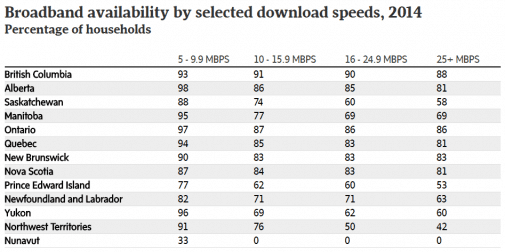Connect to Innovate – Rural Broadband Infrastructure Grants

In 2017 it’s expected that approximately 98% of Canadian households will have access to basic broadband Internet services. Although this marks a vast improvement since five or ten years ago, there are still an estimated 300,000 homes that will not have any Internet connectivity. Rural and northern communities are often the most affected by poor Internet infrastructure; even those who do have access must still deal with slow speeds and data constraints.
Connect to Innovate was introduced as part of federal Budget 2016 as a five-year (2016-2021) initiative that will commit $500 million to extend/enhance broadband service in rural and remote communities. Canadian government grants worth up to 50-90% of project costs will be provided to municipalities who establish or upgrade their backbone broadband infrastructure.
Municipalities must apply for Connect to Innovate grants by March 13, 2017. This is the only application period currently announced for the program, so interested parties should adhere to the March 13th deadline to ensure their project is considered for funding.
Connect to Innovate Grants for Rural Broadband Access
Through Connect to Innovate, it’s possible that all Canadians will soon have access to reliable broadband Internet service. The program will target northern and rural communities that have limited, unstable, or no Internet service to “bring them up to speed” with the growing need for such services.
Limited broadband Internet access is an issue that affects quality of life and the ability to drive economic growth. It’s a contributing factor to why investment and skilled labourers gravitate to metropolitan regions.
To reduce the amount of Canadians who are ‘disconnected’, the Canadian Radio-television and Telecommunications Commissions (CRTC) recently declared broadband Internet access to be a basic right. This includes speeds of at least 50 megabits/ second for downloading and at least 10 megabits/second for uploading. By providing this basic access to rural and northern Canada, it’s expected to grow the economy and promote a more connected country.
Further developing the north requires essential upgrades to Internet infrastructure; this is where Connect to Innovate will play a pivotal role.

These rural broadband access grants will focus on supporting the development of backbone connections, including fibre-optic, satellite, and microwave-based Internet infrastructure.
Supported Broadband Infrastructure Projects
There are four types of projects that may receive Canadian government funding through the Connect to Innovate program. They include:
- New Backbone Applications (up to 75-90% funding): This is the primary stream of funding and most suitable to help rural communities without a backbone connection of 1 Gbps to meet or exceed that benchmark to at least one point of presence (PoP) in each community, while connecting with at least one anchor institution.
- Backbone Upgrades (up to 50% funding): Communities with at least 1 Gbps backbone connection looking to increase their capacity to at least 10 Gbps to at least one PoP in each community, while connecting with at least one anchor institution as a result of the upgrade. These communities must also demonstrate current utilization of at least 95% or higher for a minimum of two hours per day for 14 consecutive days.
- Network Resiliency (up to 50% funding): Communities where current network resiliency (stability) is in jeopardy without an alternative data pathway. The new fibre backbone route is deployed to provide an alternative data path, increase path diversity, and network reliability for all users. The new pathway must implement sufficient failover capacity to handle all network traffic in case of failure of the main path.
- Last-Mile (up to 50-75% funding): Regions where broadband Internet is completely underserved at 5 Mbps (see eligibility map). These projects must provide at least 5/1 Mbps to households and a minimum monthly usage cap of 45GB.
Explanation of Anchor Institutions
Any upgrades to the municipality’s backbone must include connection to at least one anchor institution. By definition, anchor institutions are defined as facilities that serve a public function. This includes:
- Schools;
- Medical facilities;
- Libraries;
- First Nations band offices; and
- Other anchors around which a community is formed.
Canadian Municipalities Eligible for Connect to Innovate Funding
Municipalities eligible for the Connect to Innovate program are pre-determined based on their current Internet availability. Participants must qualify, using the Government of Canada’s broadband access map, and:
- Have a population of less than 30,000 (backbone projects);
- Identify at least one anchor institution per project (backbone projects);
- Propose to improve access for households with speeds of at least 5/1 Mbps (last-mile);
- Provide support to justify partially served last-mile;
- Identify eligible costs through a project budget and work plan; and
- Identify a commitment to provide open access to infrastructure.
How to Apply for Connect to Innovate Broadband Internet Grants
Canadian municipalities must apply for Connect to Innovate by March 13, 2017.
Applications are available via the Government of Canada’s website and can be downloaded, completed, and submitted online. If you would like to discuss your eligibility for the program, or to receive support with the application preparation, please contact Mentor Works.
Canadian Government Grants for Municipalities:
- Ontario Municipal Partnership Fund to Receive $500M in 2023
- Canadian Communities May Receive Up to $200K in Funding for Local Festivals
- Ontario Supports Communities with Anti-Racism Anti-Hate Grant
- Ontario Trillium Foundation to Provide More COVID-19 Relief Funding
- Green Municipal Fund’s Community Buildings Retrofit Initiative

